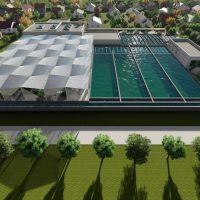Frequently Asked Questions – What Are the Main Advantages of the Organica FCR Solution?
Is it more expensive to build than a traditional treatment plant?
No – Organica WWTPs are actually constructed at very similar total costs to conventional systems, particularly when considering capacities of 5000 m3/d and above.
How is the Organica solution different from the conventional activated sludge approach?
Each Organica FCR is housed in an aesthetically-pleasing, odorless structure (greenhouse in colder climates, simple shading structures only in tropical climates) with the appearance of a botanical garden, preserving the surrounding land value and allowing the wastewater treatment plant (WWTP) to be placed directly adjacent to the wastewater source, thereby greatly reducing infrastructure costs.
Are there limitations as to the size of the WWTP?
There are no size limitations to the solution. In fact, larger facilities see more pronounced economic benefits due to increased impacts of operational and construction cost savings. Further, thanks to its modular design construction can be phased according to the pace of increasing needs on site.
How does the land requirement of an Organica facility compare to that of a traditional treatment system?
The combination of smaller reactor volumes, lower suspended solids, and creative architectural design results in land requirements up to 60% less than an activated sludge design for the same application. The smaller physical footprint results in significant land savings and reduced construction costs compared to alternative approaches
What are the operational costs?
The overall operating cost (OPEX) of an Organica FCR is significantly less than other activated sludge-based systems, primarily due to reductions in both energy demand and sludge production.
Because of the solution relies on fixed-film cultures, and less on cultures suspended in the water, the water in the reactor has lower solids concentration and is “clearer”. Oxygen transfer in clearer water is more efficient, thus less air is required to be pumped into the reactor to meet oxygen demand. This results in lower power consumption, typically 20 – 50% lower than competitive designs.
Further, due to the multilevel food chains that are present in complex ecosystems, the bacteria that process waste material are consumed by other organisms, which are in turn prey for higher predators within the food chain. This food chain effect results in lower excess sludge (commonly 20 – 30% less) at the end of the treatment process.
How energy efficient is the system?
In FCR process, the vast majority of the biomass is fixed on the natural (plant) and engineered (patented biofiber media) root structures, resulting in low suspended solids throughout each stage of the treatment process. Further, the presence of the plants helps create a loose biofilm structure, allowing oxygen to penetrate into the deepest layers of the biofilm fixed on these root structures. This combination of “cleaner” water and the loose structure results in highly efficient oxygen transfer rates, thereby lowering aeration requirements, which is the most energy-intensive part of any aerobic treatment process. The result is typically a 20-50% reduction in electricity consumption compared to other activated sludge-based solutions.


